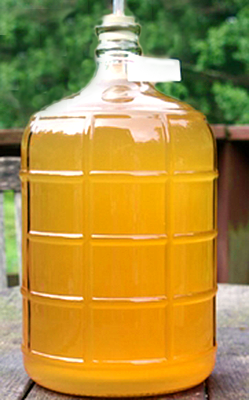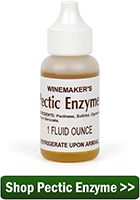 I have tried to make fresh Peach wine, it has been six weeks and it still is not clear, I followed all the basis steps in wine making, even put a clearing agent in it. Do I need just to weight longer.
I have tried to make fresh Peach wine, it has been six weeks and it still is not clear, I followed all the basis steps in wine making, even put a clearing agent in it. Do I need just to weight longer.
Thanks Tbone
—–
Hello Tbone,
What your wine may be experiencing is what’s called a pectin haze. Peach wines are notorious for having this kind of fault.
Certain fruits have a lot more pectin in them than others. Pectin is the thick, gelatinous stuff that holds the fruit’s fiber together. Peaches, strawberries and certain other fruits have an abundance of it. Normally, pectin is broken down by the yeast during the fermentation and does not cause any issues. The yeast actually produce enzymes that help to break-down the pectin resulting in a clear wine. But when there is more pectin than the yeast can handle, the result is a pectin haze.
A pectin haze cannot be settled out by a fining agent such a bentonite, isinglass or other clarifier designed to settle out particles. That’s because a pectin haze is not made up of particles. It’s made up of an organic structure that is bound to the wine itself. The only way to rid yourself of it is to break down its molecular structure.
This is where pectic enzyme comes in. If you did not add pectic enzyme to this batch, or used pectic enzyme that was too old, a pectin haze is most likely what you are dealing with. Pectic enzyme is additional enzyme that can be added to the fermentation to help the yeast break down the pectin cells. The yeast produce it naturally during the fermentation, but with some fruit – such as your peaches – it’s just not enough. More pectic enzyme needs to be added.
At this point, I would go ahead and add a double-dose of pectic enzyme to this batch. The amount will vary depending on the type of pectic enzyme you are using. Just double the recommend dosage that is stated on the container it came in.
If you purchased the pectic enzyme from us, that would be a 1/4 teaspoon per gallon – a standard dose is 1/8 teaspoon. Be sure to rack the wine into a clean fermenter first so that you do not stir up any sediment when mixing in the pectic enzyme.
The results will not be immediate. It takes pectic enzyme longer to work once the activity of the fermentation has gone. But if a pectin haze is what you are dealing with, you should start to see improvements in the wine’s clarity within a couple of weeks.
—–
Ed Kraus is a 3rd generation home brewer/winemaker and has been an owner of E. C. Kraus since 1999. He has been helping individuals make better wine and beer for over 25 years.
